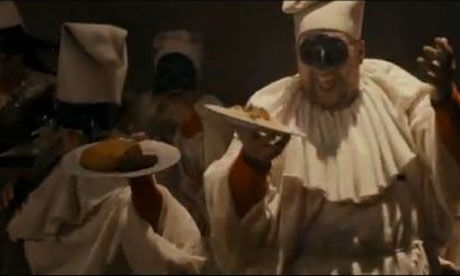
I always feel a little bit sorry for people who grew up with the foul, post-industrial, pre-Elizabeth David British catering of the 1950s and 60s; it invariably left them with an odd relationship with food. They love it (because they were permanently starving as youngsters and there was often not enough to eat), but they are also suspicious of it (because it was mostly horrible).
Public schoolboys of the time copped it the worst. At least out on the free world, you had some say over how much you ate but at boarding school the ebb and flow (too much being almost worse than too little), of barely-edible mulch was in the hands of someone else.
So it's no wonder that again and again food is a horrifying thing in the work of Monty Python – Eric Idle, Michael Palin, John Cleese and Terry Jones all attended public or independent schools, with Graham Chapman the only grammar-school boy.
You only have to watch the Mr Creosote sketch – about an obese man in a restaurant who tries to cram in a "wafer-thin" mint, only to explode horribly all over the place – with this in mind to see that it is the nightmare of little boys who had to eat every last gross thing on their plates.
Terry Gilliam, of course, was born in America, although he has been a British citizen since 1968. He escaped the tyranny of the British schooling system but he certainly seems, by the atmosphere in his short film The Wholly Family (which was financed by Italian pasta manufacturer Garofalo), to have caught a funny relationship with food off those Pythons. Or maybe it was a similar attitude to food that drew them together.
And food in The Wholly Family is undeniably nightmarish. Giant men-dollies cram rubbery spaghetti into their mouths, shaking strands aloft while making ghoulish noises. As the little hungry boy, sent to bed with no supper for being a brat, sits down at a table to get stuck in to some dream food, plates are snatched from under his nose before he can get any on his fork.
Huge silver domes are lifted off a platter to reveal, horrifyingly, the little boy's parents' heads, surrounded with parsley. At the height of his hysterical dream, the boy appears as a broken puppet and puppets, of course, don't need to eat. Food is thrown around and played with, the men-dolly waiters dance about carrying plates of this and platters of that, but the food is almost never seen – not even the apology breakfast feast the little boy rolls into his parents' bedroom in the morning (unless you count the chocolate smeared on his face) – and barely eaten.
Who knows, maybe this disrespect to food is, truly, Gilliam's idea of a nightmare; maybe he is the most terrific gourmand in his personal life and employs a Michelin-starred private chef to make him tricky little titbits for breakfast, lunch and dinner every day. But I doubt it. Like so many tortured by desperate mid-century catering (he is also a workaholic and therefore permanently in a hurry), he will love and eat, mostly, pasta.
Oh pasta, pasta, pasta! Delicious, unthreatening, filling, comforting, yummy pasta! Who wouldn't melt willingly into silky embrace of a bowl of spaghetti? It's little wonder, really, that Gilliam and Garofalo found each other. And one day, Gilliam may even lay his food demons to rest. One raviolo at a time.

